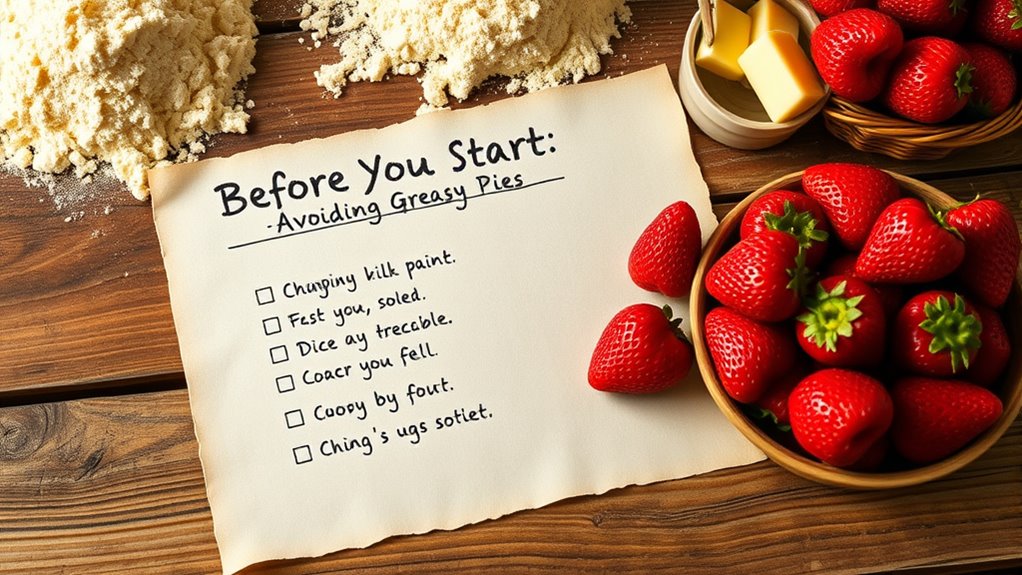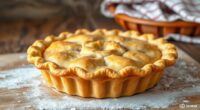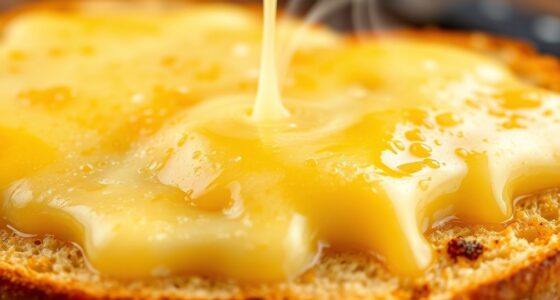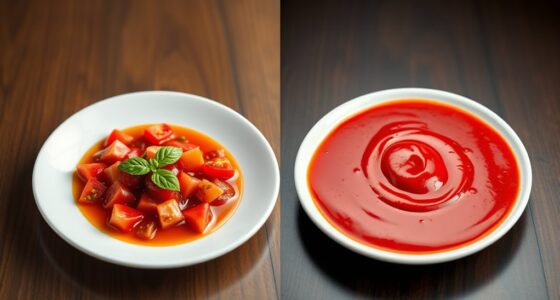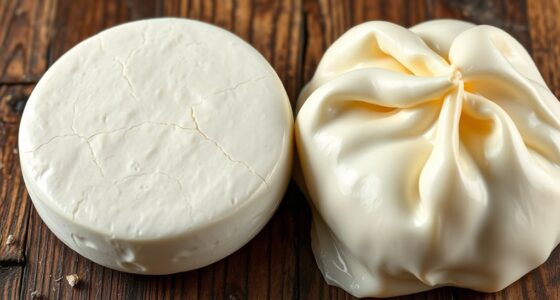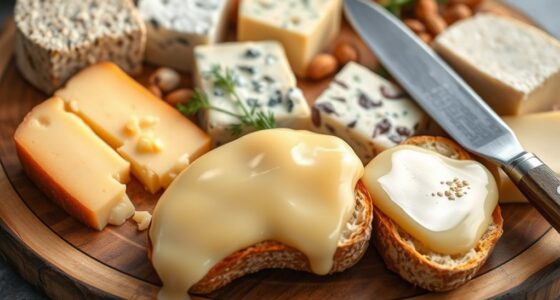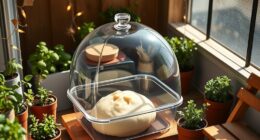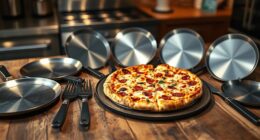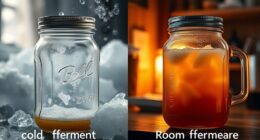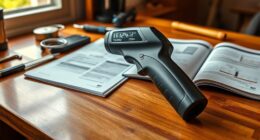To avoid greasy pies, choose lighter crust options like phyllo or whole wheat, and pre-bake your crust for added crispness. Drain excess liquids from fillings thoroughly, and thicken them with cornstarch or flour to prevent excess moisture. Control your oven temperature and remove the pie promptly once it’s golden. Using moisture barriers, such as an egg wash, can help keep oil out. Keep these tips in mind to make perfect, non-greasy pies every time—you’ll discover more tricks ahead.
Key Takeaways
- Choose lighter crusts like phyllo, whole wheat, or gluten-free options to reduce oil absorption.
- Drain excess liquids from fillings and ingredients thoroughly to prevent sogginess and greasiness.
- Pre-bake crusts and apply an egg wash or glaze to create a moisture barrier before adding fillings.
- Control oven or fryer temperature accurately and remove pies promptly to avoid over-absorption of oil.
- Use proper frying and baking techniques, including draining fried items on a wire rack and monitoring cooking times.
Tips to Prevent Greasy Pies

A greasy pie can ruin an otherwise delicious dessert or savory snack, but you can avoid this problem with a few simple tips. The key lies in understanding how to select the right ingredients and handle your pastry properly. When it comes to pastry alternatives, opting for lighter, less oily options can make a notable difference. Consider using alternatives like phyllo dough, which crisps up beautifully without absorbing excessive oil, or try a whole wheat or gluten-free crust that tends to be less greasy. These options not only reduce oil absorption but also add variety and flavor to your pies.
Another vital aspect is mastering oil absorption techniques. Excess oil in your crust or filling creates that undesirable greasy texture. To prevent this, you need to control how much oil your ingredients absorb during preparation. For instance, if you’re working with grated vegetables or fruits that release moisture and oil, squeeze out excess liquid thoroughly before mixing them into your filling. When frying or baking, ensure your oven or fryer is at the right temperature—too low, and your pastry will soak up more oil; too high, and it might burn. Using a wire rack to drain excess oil from fried items can also help keep the pie less greasy.
Control oil absorption by draining excess liquids and maintaining proper oven or fryer temperatures.
Pre-baking or blind baking your crust can further reduce greasiness. By pre-baking the pastry for a few minutes before adding the filling, you create a barrier that limits oil penetration. This step is especially useful when working with rich or moist fillings that tend to make the crust soggy and greasy. Additionally, applying a thin layer of egg wash or a glaze before filling can act as a moisture barrier, preventing the filling from seeping into your crust and causing excess oil absorption.
Pay attention to your filling’s moisture content too. High-moisture fillings can cause the crust to become soggy and greasy. To avoid this, drain excess liquids or thicken the filling with ingredients like cornstarch or flour. This not only keeps the filling stable but also reduces the likelihood of oil seeping into the crust during baking. Incorporating proper baking techniques can further ensure your pies stay crisp and not greasy.
Finally, be mindful of your baking or frying time. Overcooking can lead to increased oil absorption and greasiness. Keep a close eye on your pie, removing it promptly when it’s golden and cooked through. By combining these strategies—using pastry alternatives, implementing proper oil absorption techniques, pre-baking, and managing filling moisture—you’ll notably improve your chances of baking pies that are crisp, flavorful, and not greasy.
Frequently Asked Questions
Can Using Low-Fat Ingredients Reduce Grease in Pies?
Yes, using low-fat options can reduce grease in pies. By making ingredient swaps, like selecting low-fat dairy or reducing butter, you cut down on excess fat that causes greasiness. These swaps maintain flavor while making your pie lighter. Keep in mind, though, that some adjustments may affect texture, so experiment with different low-fat options to find the best balance for a delicious, less greasy pie.
Does Blind Baking Help Prevent Greasy Bottoms?
Yes, blind baking helps prevent greasy bottoms by setting the crust before adding wet fillings. When you blind bake, you can control the crust thickness, guaranteeing it’s sturdy enough to hold moisture without becoming soggy. This technique creates a barrier that reduces grease absorption, keeping your pie bottom crisp and less greasy. Always use pie weights during blind baking to guarantee an even, flaky crust and ideal results.
How Does Filling Moisture Affect Pie Greasiness?
If your filling has too much moisture, it can make pie crusts greasy and soggy. You might think a juicy filling is irresistible, but excess moisture releases steam that weakens the crust. To prevent this, reduce filling moisture by draining excess liquids or thickening with a starch. This way, your pie crust stays crisp and delicious, and your filling remains flavorful without turning greasy.
Are Certain Types of Crust Less Prone to Greasiness?
Certain alternative crusts are less prone to greasiness because they typically have lower fat content or use healthier fats. For example, whole wheat or gluten-free crusts often contain less butter or shortening, reducing greasiness. You can also try crusts made from oats or nuts, which absorb less fat and provide a sturdier texture. By choosing these options, you’ll enjoy a less greasy, more balanced pie crust.
What Are Common Mistakes That Lead to Greasy Pies?
Overloading your pie with filling or rushing the filling preparation can turn it greasy. Be mindful of your crust selection; choosing a flaky or buttery crust might be more prone to greasiness if not handled properly. Avoid using too much butter or oil in your filling, and don’t forget to drain excess moisture from ingredients. Properly preparing your filling and selecting the right crust helps prevent that unwanted greasy look and taste.
Conclusion
Now that you’ve got the tricks up your sleeve, making perfect, non-greasy pies is well within your reach. Just remember to drain excess fat, use the right crust, and avoid overfilling. Think of it as your culinary quest—like a knight of the kitchen, battling greasy foes with a trusty checklist. Keep these tips in mind, and your pies will turn out crisp, delicious, and downright delightful every time. Happy baking, and may your pies always be as perfect as a fairytale ending!
